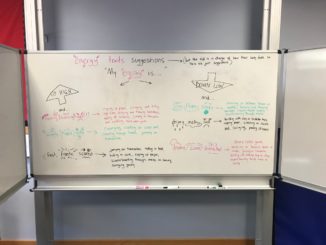In the infamous “Duck Cake” episode of Bluey (season 2, ep 44), it’s little sister Bingo’s birthday and she is looking through a cake book for which cake she would like to have for her birthday. She chooses a duck cake because, when she looks at it, her tail starts wagging, which she knows means that she is happy.

She even asks Mum on the way out the door, “How do animals without tails know when they’re happy?” Obviously, a playful nod to the fact that viewers are, y’know, not dogs.
But it’s an insightful question! How *do* animals without tails know when they’re happy? How do humans know that they’re feeling any emotion at all?
Connecting body sensations (like a tail wagging…or, in our case, maybe a fluttery feeling in the gut, or a hot/blushy feeling in the cheeks, or a wiggly feeling in the hands or toes, or any one of a zillion body sensations that we have to interpret) with our emotional feelings is a challenging process in the way that learning language is a challenging process: it’s basically miraculous that anyone ever does it successfully, our brains are generally hard-wired to do it for us as we grow and learn, and yet sometimes things go awry or have a harder time coming out correctly.
This process, by the way, is called “interoception”: connecting our internal body sensations with our emotional feelings. (It’s tricky, too, because we use one word “feelings” to mean both “physical sensations” and also “emotional states of being”.)
What Bingo was saying, although she probably didn’t know it, is, “I already know how to interpret my body signals for ‘happiness’ — I wonder how someone different than me could do it!”
And that’s a good thing to wonder, because a key facet of interoception is that all of our body signals are not necessarily the same!
Sure, there are some that are often in common. Churning feeling in the stomach is often associated with anxiety, for many people. Tears welling up in the eyes is often associated with sadness, for many people. But not *all* people, and not *only* that sensation. There could be as many different bodily responses to feelings as there are people in the world.
Some people smile or laugh when they are happy. But some people smile or laugh when they are uncomfortable, shocked, or upset. (This can lead some adults to get really angry with children for appearing callous or flippant when they’re actually showing how uncomfortable they are with whatever is going wrong.)
When I feel very happy, I feel a swelling sensation in my stomach, like I’ve just taken a huge deep breath (even if I haven’t). My hands and wrists feel light and faraway, as if I’m disconnected with them; that feeling makes me want to flap my hands and wrists to feel the internal relief of return of normal sensation to them. The intensity may build into my head, which makes me want to open my mouth wide, or it may spread into my feet, which makes me want to jump up and down.
If I can be by myself in my office or step into the bathroom, I might do any of those things — flap, jump, grimace/grin. If I’m around people who I’m very close to, I might do one of them, but I feel acutely aware of looking “different” or being “watched”. Or— I can hold my breath and wait for the intensest part of the sensation to pass, if I need to. It usually passes in about 30-60 seconds, and then I just feel calmly content or an excited “buzzy” feeling in my skin.
I’ll bet that some of you reading this have a different response to happiness than I do.
I know Bingo does. Her response to happiness is to wag her tail!



